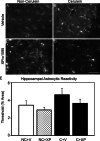Selective inhibition of soluble TNF using XPro1595 relieves pain and attenuates cerulein-induced pathology in mice
- PMID: 34049483
- PMCID: PMC8161932
- DOI: 10.1186/s12876-021-01827-0
Selective inhibition of soluble TNF using XPro1595 relieves pain and attenuates cerulein-induced pathology in mice
Abstract
Background: Symptoms associated with acute pancreatitis can be debilitating, and treatment remains a challenge. This study aimed to investigate the efficacy of selectively inhibiting the soluble form of TNF (solTNF) using the biologic XPro1595 in a mouse model of acute pancreatitis.
Methods: Acute pancreatitis was induced in adult male C57Bl/6J mice by administering cerulein (8 injections of 50 µg/kg I.P., spaced an hour apart), with XPro1595 (10 mg/kg, S.C.) or vehicle being administered approximately 18 h after the last injection. Serum was collected 6 or 18 h after the last cerulein injection, pancreatic tissue was collected 2 and 7 days post-induction, and brain hippocampal tissue was collected at 7 days post-induction. The animal's pain level was assessed 3, 5 and 7 days post-induction.
Results: The induction of acute pancreatitis promoted a strong increase in serum amylase levels, which had receded back to baseline levels by the next morning. XPro1595 treatment began after amylase levels had subsided at 18 h, and prevented pancreatic immune cell infiltration, that subsequently prevented tissue disruption and acinar cell death. These improvements in pathology were associated with a significant reduction in mechanical hypersensitivity (neuropathic pain). XPro1595 treatment also prevented an increase in hippocampal astrocyte reactivity, that may be associated with the prevention of neuropathic pain in this mouse model.
Conclusion: Overall, we observed that selectively inhibiting solTNF using XPro1595 improved the pathophysiological and neurological sequelae of cerulein-induced pancreatitis in mice, which provides support of its use in patients with pancreatitis.
Keywords: Acute pancreatitis; Cerulein; Cytokines; Inflammation; Mice; Neuropathic pain; TNF; TNFR1.
Conflict of interest statement
The authors declare that they have no competing interests.
Figures





Similar articles
-
Selective Inhibition of Soluble TNF using XPro1595 Improves Hippocampal Pathology to Promote Improved Neurological Recovery Following Traumatic Brain Injury in Mice.CNS Neurol Disord Drug Targets. 2023;22(9):1378-1390. doi: 10.2174/1871527321666220610104908. CNS Neurol Disord Drug Targets. 2023. PMID: 35692164
-
Lupeol Protects Against Cerulein-Induced Acute Pancreatitis in Mice.Phytother Res. 2015 Oct;29(10):1634-9. doi: 10.1002/ptr.5423. Epub 2015 Jul 16. Phytother Res. 2015. PMID: 26179197
-
The Effects of Lycium Barbarum Polysaccharide (LBP) in a Mouse Model of Cerulein-Induced Acute Pancreatitis.Med Sci Monit. 2019 May 25;25:3880-3886. doi: 10.12659/MSM.913820. Med Sci Monit. 2019. PMID: 31127077 Free PMC article.
-
[B7-H3 monoclonal antibody attenuates the inflammation and tissue injury in mice with cerulein-induced acute pancreatitis].Xi Bao Yu Fen Zi Mian Yi Xue Za Zhi. 2016 Mar;32(3):323-7. Xi Bao Yu Fen Zi Mian Yi Xue Za Zhi. 2016. PMID: 26927550 Chinese.
-
[Resolvin D1 Reduces Cerulein and Lipopolysaccharide-induced Severe Acute Pancreatitis in Mice Fracture Patients].Sichuan Da Xue Xue Bao Yi Xue Ban. 2019 Mar;50(2):215-218. Sichuan Da Xue Xue Bao Yi Xue Ban. 2019. PMID: 31106542 Chinese.
Cited by
-
TNF and TNF receptors as therapeutic targets for rheumatic diseases and beyond.Nat Rev Rheumatol. 2023 Sep;19(9):576-591. doi: 10.1038/s41584-023-01002-7. Epub 2023 Aug 4. Nat Rev Rheumatol. 2023. PMID: 37542139 Review.
-
Apoptotic cell death in disease-Current understanding of the NCCD 2023.Cell Death Differ. 2023 May;30(5):1097-1154. doi: 10.1038/s41418-023-01153-w. Epub 2023 Apr 26. Cell Death Differ. 2023. PMID: 37100955 Free PMC article. Review.
-
Blueprint of Collapse: Precision Biomarkers, Molecular Cascades, and the Engineered Decline of Fast-Progressing ALS.Int J Mol Sci. 2025 Aug 21;26(16):8072. doi: 10.3390/ijms26168072. Int J Mol Sci. 2025. PMID: 40869392 Free PMC article. Review.
References
-
- Grewal HP, Kotb M, el Din AM, Ohman M, Salem A, Gaber L, et al. Induction of tumor necrosis factor in severe acute pancreatitis and its subsequent reduction after hepatic passage. Surgery. 1994;115(2):213–221. - PubMed
MeSH terms
Substances
Grants and funding
LinkOut - more resources
Full Text Sources
Other Literature Sources
Medical

